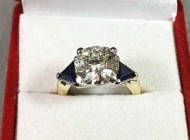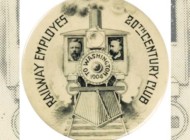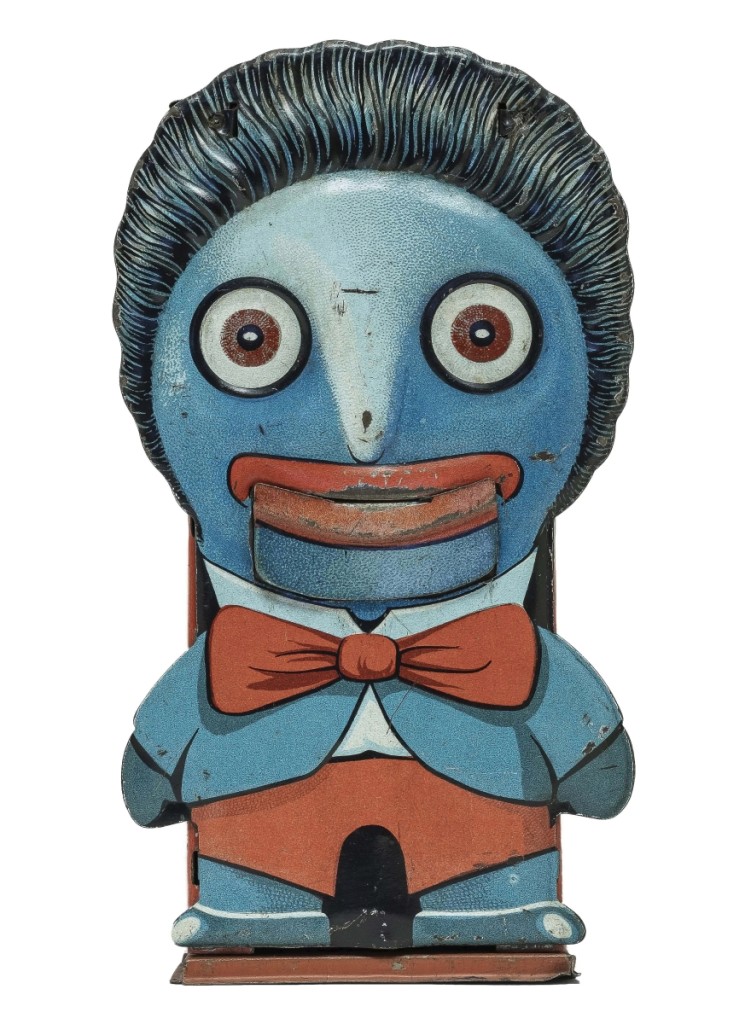
Only three or four tin lithographed Golliwog banks by Saalheimer & Strauss are known. Four bidders chased it to $21,600, the second highest lot in the sale. Leon Weiss said it was likely made for the English market.
Review by Greg Smith
WHITEHOUSE STATION, N.J. – In the foreword to RSL Auction Co’s catalog illustrating its June 27 sale of the bank and cap gun collection that belonged to the late Paul Cole, Steven Weiss recounted the first time he met the venerable collector at an Ohio auction in 1983.
“We talked and talked all through the auction. I remember that we were even reprimanded by the auctioneer for talking too loudly…I had intended to take a long taxi ride home to my grandmother’s house in Cleveland, but Paul insisted on driving me himself…adding nearly three hours to his drive time.”
Cole collected antique toys for nearly 50 years, filling many of the field’s more narrow categories with fine and rare examples from both American and European makers. From his home base in Bluefield, W.Va., Cole proselytized his hobby with a knowledgeable enthusiasm that saw him take the helm as president of the Antique Toy Collectors of America club.
Following his passing in 2020, Cole’s expansive train collection totaled more than $2.5 million at a New Jersey auction house in late May, but the collector’s treasures were far from tapped. The family turned to RSL to sell off his 552-lot bank and cap gun collection with the total drawing in an additional $1,024,000.
Auctioneer Leon Weiss said that much of this material had passed into Cole’s collection from his auction house or Gemini Antiques, the Weisses’ private dealership.
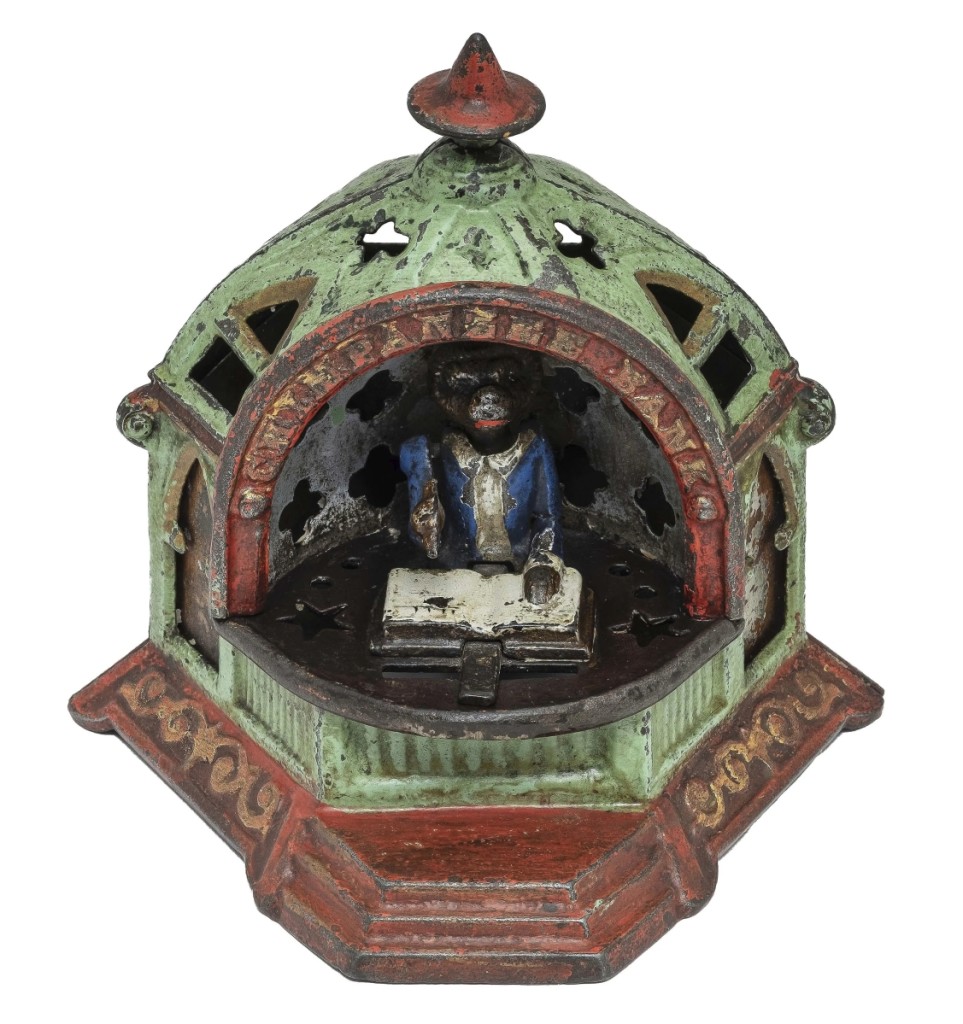
The sale’s top lot was this Kyser & Rex Chimpanzee iron mechanical bank that sold for $26,400. The well-dressed chimpanzee sits at his desk and dutifully logs each deposit made into his ledger.
Mechanical banks were led at $26,400 by an iron Chimpanzee bank by Kyser & Rex, circa the 1880s. The auction house said the subject alludes to the then-controversial theory of evolution, published in Darwin’s On The Origin Of Species in 1859 about 20 years earlier. When a deposit is made into the bank, the action depicts the formally dressed chimpanzee logging it into the ledger before him as if he was a banker. In the early 1880s, American mechanical bank designer Charles Bailey independently produced a small group of toy banks cast in lead. Among them was the Baby Elephant Unlocks at X O’Clock bank, which featured an elephant dangling a man over an alligator’s wide-open mouth, the figure lamenting “Oh if I had only put some money in the bank.” With a restored clock hand, the bank sold for $18,000. Another example featuring a clock was the Time Lock Savings Bank, produced by Louis Mfg Company of New York City in 1892. The bank served the dual role as a functional mantel clock and the owner could set it to seal itself for up to seven days. Bidders thought that was neat and it sold for $13,800. Always a crowd pleaser is the Confectionary Bank by Kyser & Rex, circa the early 1880s, that brought $12,000. Cole’s example featured a red and blue counter with a golden yellow cabinet of drawers behind under red painted letters and a red bonnet. Also from Kyser & Rex was The Motor Bank that brought $5,400. The auction house noted the model was a commercial failure for the company – its complex mechanism failing more often than not – though it remains prized among collectors.
Cole’s strongest cast iron still banks were all architectural in nature. Bidders coveted a Large House with Chimney slot that vaulted its $3,500 high estimate to take $9,600. It was from an unknown manufacturer and featured a black house, gilt steps and lettering and a chimney highlighted in red to its base. The house measured 4 inches high.
“That is an exceedingly rare bank,” Leon Weiss said. “Maybe three or four known. Three people competed, all three have at least 2,000 still banks each and none of them had it – that’s how rare it is.”
A bit taller at 8½ inches high and 15½ inches wide was a large-size Independence Hall, known to be the largest of all cast still banks, that brought $7,800. Fewer than ten of these banks are known to exist. Taller yet at 10½ inches high was an Eagle Bank with Mansard Roof, produced by an unknown American manufacturer in the late 1880s, in excellent condition, that sold for $2,040. From the Grey Iron Casting Company in Pennsylvania was a remarkably detailed paint-decorated State Bank, which sold for $2,640. With painted highlights delineating the individual bricks of the building, combined with brightly gilt door and windows, the auction house said it was the most complex and developed detailing they had ever seen on this bank. Selling at $6,600 was a Boston State House Bank made by Smith & Egge, circa 1880. A powder blue House with Bay Windows with a red roof and green gable came from an unknown manufacturer but was bright enough that bidders took it to $7,200. With provenance to Mark Suomi, a Building with Belfry by Kenton Hardware would take $4,200. The 8-inch-tall bank featured a bright gilt paint to its architectural columns, window panes, doors, belfry supports and finial.
Among Cole’s figural cast iron still banks was an entire unit of Mulligans, an old pejorative for Irish beat cops – he had 23 of them with 15 advertising various clothiers. Two were produced by Hubley, one by Arcade and the rest from AC Williams. They sold from $60 to $2,400, the top made for an AC Williams example advertising “Smith the Shoeman.”
When the Columbian Exposition opened in Chicago in 1893, English manufacturer John Harper Ltd produced The Chicago Bank as a souvenir for attendees. In exceptional condition, Cole’s example sold for $4,800.
Tin still banks were led by a Church bank at $8,400 with a white exterior, black roof and a spire that featured a ringing bell. It was produced by the Merriam Mfg Company in Durham, Conn., and had provenance to Donal Markey.
That result still paled in comparison to his best tin mechanical bank, the 1920s Golliwog by Saalheimer & Strauss, that fetched $21,600. The auction house said only three or four of these specimens are known, making it one of the most elusive tin mechanicals out there. Weiss said he had four bidders vying for the lot. Also from the maker was a tiger at $6,600 and a lion at $5,400.
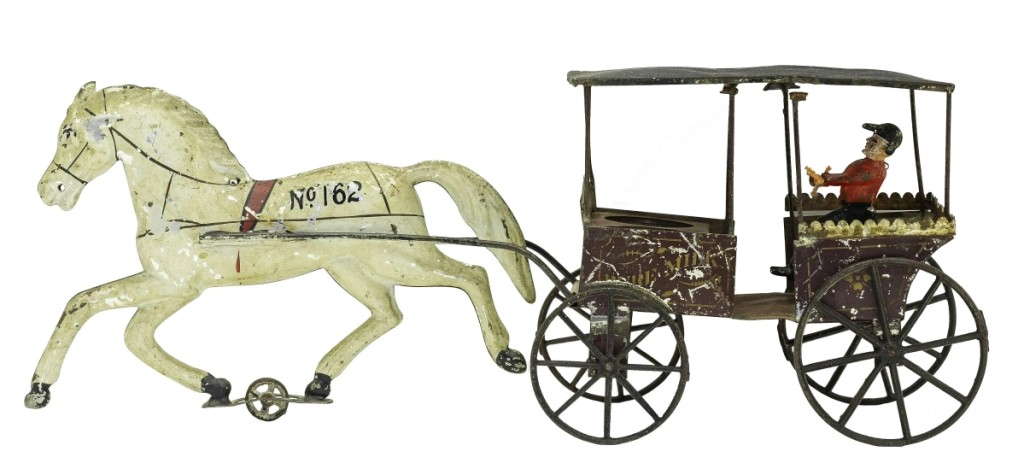
Leon Weiss believed that the painted No 162 on this Merriam Mfg Co., Pure Milk Delivery Wagon, a tin toy, may have correlated to its model number used to order it from the company. “Maybe no one ever did, though,” Weiss said, “We’ve never seen another.” It was in the Weiss Family collection for more than 20 years before passing to William Holland and Bernard Barenholtz. It sold for $12,000.
Once a valued member of the Weiss Family collection for more than 20 years, a Merriam Mfg Co., No. 162 Pure Milk Delivery Wagon toy sold for $12,000. Its provenance also included William Holland and Bernard Barenholtz. “It is truly one of the finest toys I have run across by the Merriam Company,” Weiss wrote, noting he knows of no other examples of this toy. Behind at $11,400 was a mechanical tin “Pegasus” locomotive by Ives, Blakeslee & Company. The auction house said it was one of the finest and most complex mechanical tin toys made in the Nineteenth Century. The example had been discovered in a Long Island attic about ten years ago. Condition drove the result on a Farmer Chasing After His Pigs toy by Fallows, which brought $11,400.
Top among cap guns at $4,500 was a rare black cat example by Ives, Blakeslee & Company, which patented it in 1882. The cat appears sitting with his long tail looping downward to form the handle. The firm said its among the most significant and sought-after cap pistols in the hobby. At $4,200 was an Uncle Sam Said Git example that had provenance to the Hegarty collection. RSL called it “one of the most historically significant playthings created in the Nineteenth Century” as it featured Uncle Sam booting a Spanish admiral off the barrel of the gun, like a plank. The side of the gun reads “Dewey – Remember the Maine – We Do – We Did It,” referring to Spanish-American War hero Admiral George Dewey, who demolished the Spanish Pacific Squadron with only one casualty on his side in one of the most decisive naval battles in American history.
“The sale did exceedingly well,” Leon Weiss said. “It exceeded our expectations by about 12 to 15 percent.”
RSL will hold its inaugural “Créme de la Créme Auction” on August 21, offering a premier and boutique assortment of still and mechanical banks, iron and tin toys, and American folk art. The firm said this sale will take place once yearly in the summer.
All prices reported include buyer’s premium. For information, www.rslauctionco.com or 908-823-4049.




























